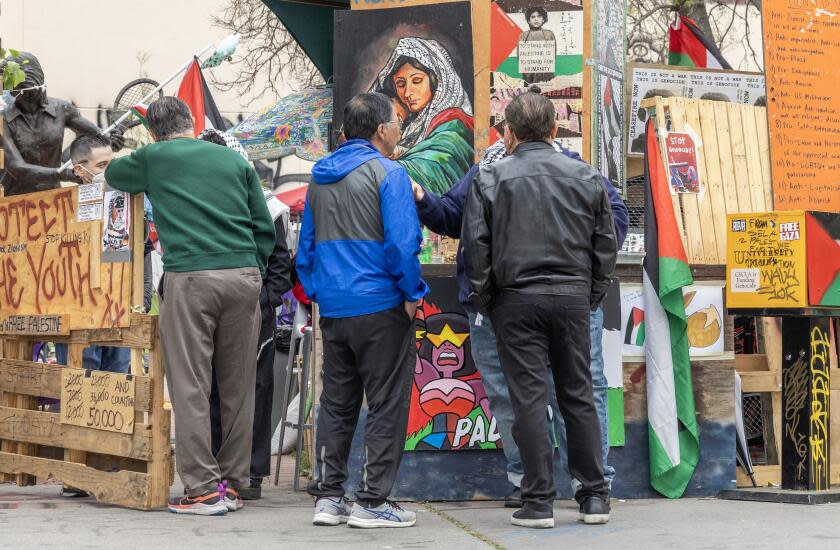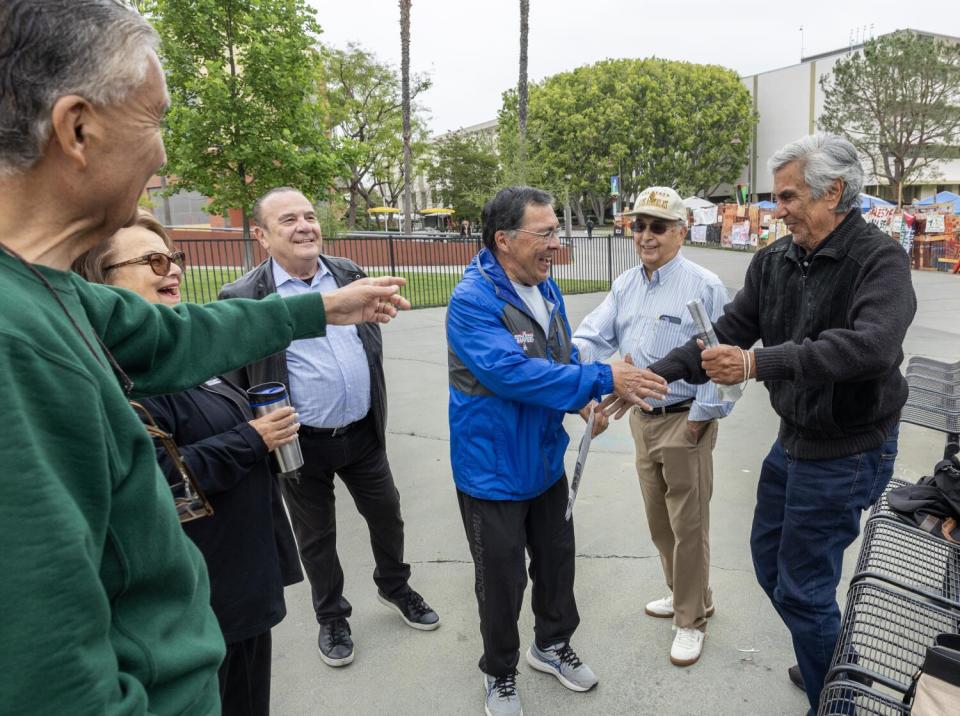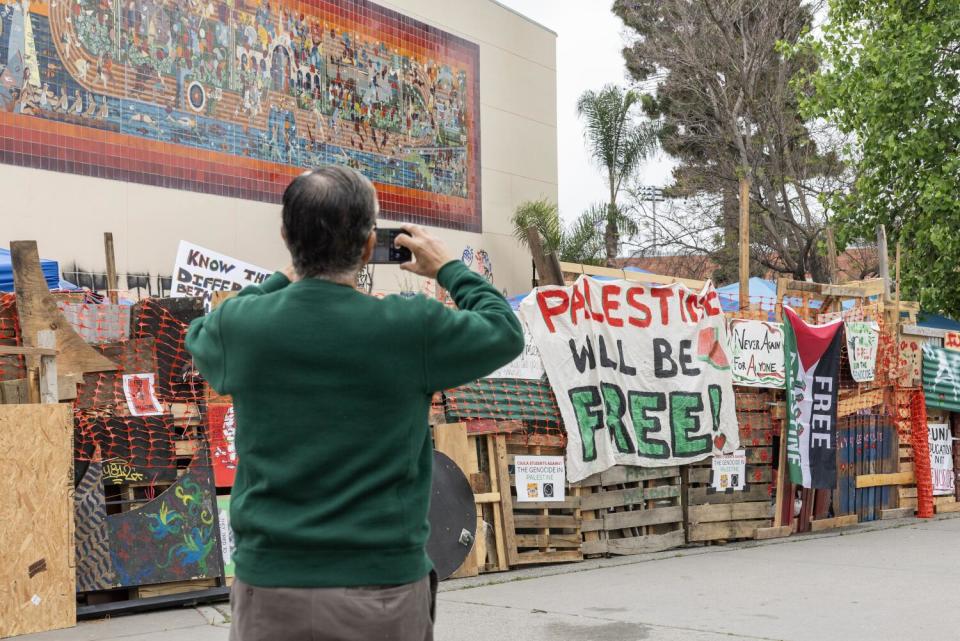Column: A meeting of Cal State L.A. student encampments, 55 years apart

An all-star lineup of Cal State Los Angeles Chicano alumni showed up Saturday morning to check out the school’s growing pro-Palestinian encampment. But curiosity wasn’t the main reason they came to the tents.
The six, all in their late 70s or early 80s, also came to remember.
Fifty-five years ago this June, they were part of a weeklong campout — officially called “el encampamento” (the encampment) — at that exact location, next to the gym.
Today, the protesters are demanding that Cal State L.A. drop all investments with Israel, boycott organizations with ties to the country and call for a permanent cease-fire in the Gaza Strip.
Back then, activists wanted a Chicano Studies program, a community center and more Chicano students at the then-overwhelmingly white campus. They also asked administrators to fight a plan by then-California Gov. Ronald Reagan to gut the school’s Educational Opportunity Program, which helped first-generation college students.
“I was really happy when I heard about this encampamento,” said Phillip Castruita, a co-founder of Cal State L.A.'s first Latino activist group, United Mexican American Students. “The spirit of students is still around, and it's important that they know about what's happening in the world.”
He sat on a bench a stone’s throw away from the current encampment, which was in its third week, joining similar pro-Palestinian protests at universities around the country. Young men and women in graduation gowns and sashes walked past us on the way to pose for photos elsewhere.
Read more: Column: Pringles, plywood and chalk: The supply chain sustaining the Cal State L.A. encampment
We were soon joined by retired USC Annenberg professor Félix Gutiérrez, with Vickie Castro, Monte Perez, Richard Santillan and Raul Cardoza arriving a few minutes later. The plan: introduce themselves to the new generation of student activists and hopefully enter their tent town.
The 1969 encampamento is little remembered except by those who were there. But it was pioneering in many ways. It carried the demands of the far more famous Chicano "Blowouts" — the Eastside high school walkouts of a year earlier, which many of the six had helped organize — to higher education. It showed that working-class students were as committed to direct actions as their peers at UCs and private universities.
More importantly, the encampamento led to results. Administrators agreed to most of its demands. Many who joined say it was a catalyst for the course of their lives.
“It got us involved in leadership,” said Cardoza, who was a high school math teacher in Montebello at the time and eventually became president of Chabot College in Hayward.
“All of us carried what we learned from it,” said Gutiérrez, who handled media relations during the encampamento because he was a former Cal State L.A. administrator.
Besides Cardoza and Gutiérrez, who were Cal State L.A. alums at the time, the rest of the six were students.
“We always remained activists afterward,” said Castro, a Cal State L.A. student at the time who later became the second Latina on the Los Angeles Unified school board. “Always.”

The idea for a campout came after a series of protests on campus against Reagan, who vilified student activists up and down California from the moment he became governor in 1967.
“He had called student protesters ‘trash,’” said Castruita. “That was what we had to live with.”
“We kept getting warned that if we did direct actions, it would follow us forever,” added Santillan, a retired political science professor and longtime chronicler of Mexican American baseball. He and Perez were arrested along with 33 other protesters months after the Blowouts for refusing to leave the Los Angeles County Board of Education chambers.
The encampamento began with a rally of about 250 people at Eugene A. Obregon Park that kicked off a two-mile march to Cal State L.A. “We had support from everyone,” Cardoza said. “Military veterans. Pintos [ex-convicts]. Our parents, our siblings.”
“My grandmother marched with us,” Santillan added. "We appeared in the newspaper together!"
About 40 people set up sleeping bags in what the school had designated as its free-speech zone.
“See where that white tent is?” Castro said, waving toward the middle of the pro-Palestinian encampment. A canopy peeked over the barricades. “There was a podium there, and people would talk from there.”
Hundreds of community members visited the encampamento during its six days. Sal Castro, the high school teacher who had inspired his students to walk out, gave a speech. Baile folklórico performances were scheduled, along with art workshops and films. People dropped off tacos, burritos and tamales. Meanwhile, Santillan said, the main participants "mostly studied" for finals.
“I used to cheat and go take a shower at home,” Castro said with a laugh.
Read more: Opinion: College students were 'woke' in the 60s and annoying to their elders. Meet their successors
Perez, who retired in 2021 after a decade as president of Los Angeles Mission College and then served as interim Fullerton College president, said their encampment — unlike the current one — wasn't enclosed, “because we wanted to interact with students. There was no negativity. People would approach us and ask, ‘Why are you here?’ and we'd explain what we were doing.”
Gutiérrez remembers going out to get carnitas with future L.A. County Dist. Atty. Steve Cooley, who was Cal State L.A.’s student body president at the time.
“He just didn't understand,” said Gutiérrez, himself a former student body president (he beat future L.A. County Supervisor Mike Antonovich). “Steve would ask, ‘Why do you have to use those tactics?’ and I’d tell him why we did it. He was genuine in his curiosity.”
The group suddenly got quiet. Cal State L.A. Chicana(o) and Latina(o) Studies Chair Anita Revilla Tijerina was approaching. “I want to take a picture with all of you!” she exclaimed.
“I feel honored to be on the shoulders of these activists and visionaries,” Revilla Tijerina told me. “They had the vision of creating the pathway to what we have today.”
I asked why she thought the stereotype persists that students at Cal States and community colleges don’t engage in activism.
“As long as working-class students have been on campus, they've been trying to change the world,” Revilla Tijerina replied. “The media pays attention to the wealthy schools. Most of my students are working full-time and still protesting."
“So were we," Santillan replied.
After she left, the six described how their encampamento ended with a rally at Cal State L.A.’s stadium attended by over 2,000 people. Mariachi Los Camperos performed. Legendary Democratic politician Jesse Unruh told the crowd, “Unless we are willing to admit that there is something wrong with our educational system and promote programs designed to remove inequalities, no amount of force is going to be enough to contain the unrest.”
I asked them what they thought about the current pro-Palestinian encampment. They stayed quiet for a moment.
“We didn’t have barricades,” said Perez.
“We didn’t do any damage,” Castro said, looking at graffiti that had crept up the gym wall. “Sorry, that’s the principal in me.”
"It was local issues for us," Perez continued. "We weren't looking to other parts of the world."
“Every generation has their own issues,” Cardoza countered.
“Civil disobedience is always going to be a part of a movement,” Gutiérrez offered.
“These students are fighting militarism, they're asking for disinvestment, they're putting themselves out there, and I respect that,” Castruita said.
What advice did they have for the current campers?
“Stay strong.”
“Stay focused."
“You’re doing well."
“We’re proud."

Santillan, Gutiérrez, Perez and Cardoza then walked over to the encampment, ringed with pallets and covered in artwork and banners. A masked woman with a kaffiyeh wrapped around her head guarded the entrance. Other campers emerged. I watched from afar, allowing them a moment of privacy and not wanting to jeopardize their chances of getting in.
The four men shook hands with activists young enough to be their grandchildren. There were smiles, conversations. Pharrell Williams’ “Happy” played from a nearby graduation party. After about 10 minutes, Gutiérrez returned to where Castruita and I had remained.
“It was a healthy conversation,” he said. “But they won't let us in. They're about to discuss negotiations with administrators."
Gutíerrez offered a slight nod. "We respect that.”
Castruita and I joined Santillan, Perez and Cardoza. They were listening to Joel Chavez, who had greeted them just next to the encampment entrance.
“The core of Chicano Studies is social justice, so how could you not be called into action?” said the master’s degree candidate in Chicana(o) and Latina(o) studies as his elders listened. “History will show, just like y'all, that we were on the right side of justice.”
Nearby, Marco Durant had a stunned look on his face. Santillan was his professor at Mt. San Antonio College about a decade ago.
“I remember him talking about his stories about being a student activist, but I wasn’t paying attention then,” said Durant, who had just visited the encampment, his white mask barely concealing his large grin. “And he’s here now! He laid the groundwork for the rest of my academic career.”
Durant was preparing to walk in Cal State L.A.’s graduation ceremony for his master’s in history.
"Them being here shows the continuation of the struggle," he said. "The same struggle but different actors. Their legacy carries to us, and hopefully we can carry it to the next generation.”
Santillan beamed. "I'm so proud of you, Marco," he said as he left.
Other student activists filed past their predecessors and into the encampment, ready for a new day.
This story originally appeared in Los Angeles Times.

